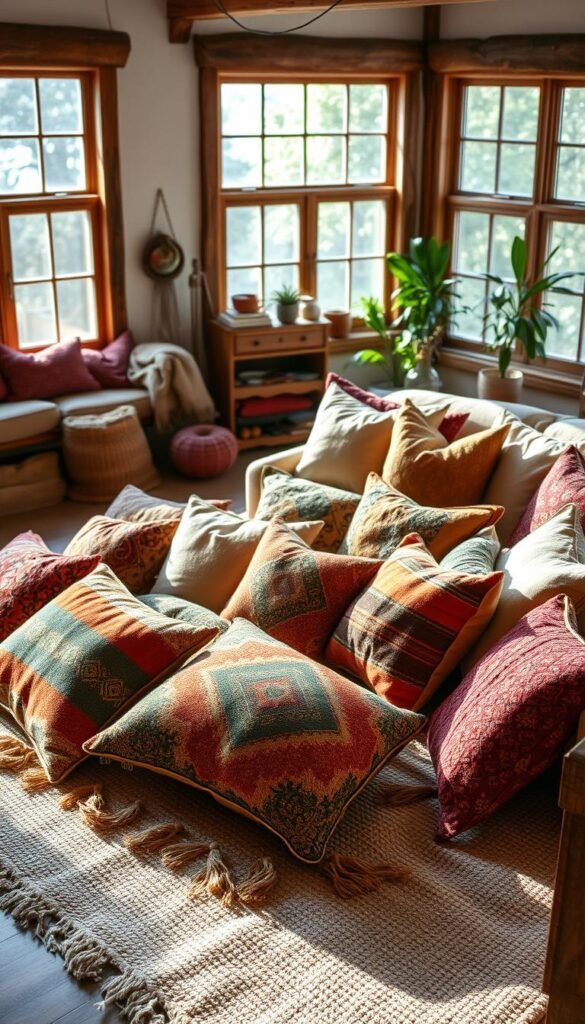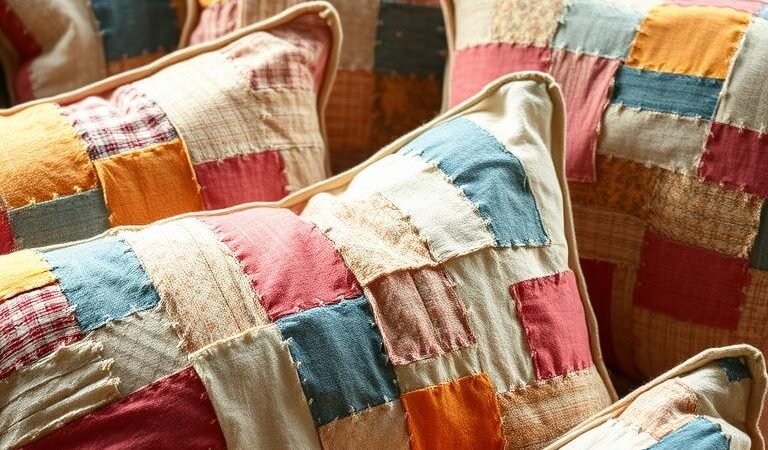Breathing new life into unused materials is a creative way to enhance your living space. Many crafters have drawers filled with forgotten textile pieces—remnants from past projects or worn-out clothes. These overlooked treasures hold endless potential for stylish home decor.
The art of repurposing materials blends sustainability with self-expression. Across cultures, from vibrant Guatemalan markets to modern urban studios, creative reuse has shaped design traditions. Simple projects like decorative cushions offer an ideal starting point for beginners.
This guide will help you turn overlooked materials into eye-catching accents. The process combines practical decluttering with artistic satisfaction. Whether you’re an experienced maker or just starting, these techniques adapt to any skill level.
Key Takeaways
- Unused textiles can become beautiful home accessories
- Creative reuse connects to global design traditions
- Simple projects work well for all experience levels
- The process combines organization with artistic joy
- Personalized accents reflect your unique style
Why Upcycle Fabric Scraps into Throw Pillows?
Every year, millions of tons of discarded fabrics could become beautiful home decor instead of landfill waste. The EPA reports that 11 million tons of textiles clog U.S. landfills annually—enough to fill 70,000 garbage trucks. Repurposing even a small fraction of this material reduces environmental strain while adding personality to your living room.
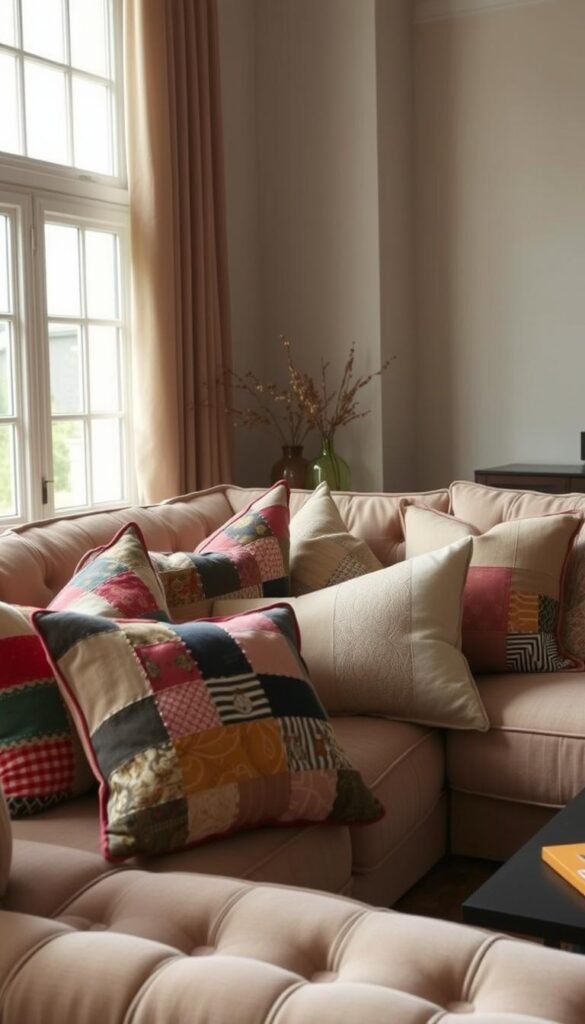
The Environmental Impact of Discarded Fabrics
Manufacturing new textiles consumes vast resources. For example, upcycling a single cotton sheet saves 700 gallons of water. Unlike mass-produced goods, handmade items often use existing materials, cutting energy use by up to 85%. This visible waste reduction transforms clutter into functional art, like the vibrant patchwork pillows found in Guatemalan markets.
Artistic Freedom Through Patchwork
Scrap-based projects encourage experimentation. Mixing textures—lace with linen, or denim with silk—creates tactile depth. Many crafters describe patchwork as meditative, where arranging irregular shapes becomes a form of storytelling. A thrifted textiles project, for instance, might blend a grandfather’s flannel shirt with vintage tea towels for sentimental appeal.
Budget-Friendly Home Styling
Store-bought decor often costs 3-5 times more than handmade alternatives. By using scraps, one blogger crafted a $5 pillow from an H&M towel, versus $75 for a retail version. Over time, these savings add up—especially when 25% of wardrobe fabrics can be repurposed. The result? Unique, heirloom-quality pieces that outlast fast-fashion trends.
Materials Needed for Your Scrap Fabric Pillows
Gathering the right materials transforms leftover textiles into cozy home accents. Whether using vintage sheets or clothing remnants, quality components ensure durability. This checklist covers everything from basic tools to innovative filling options.
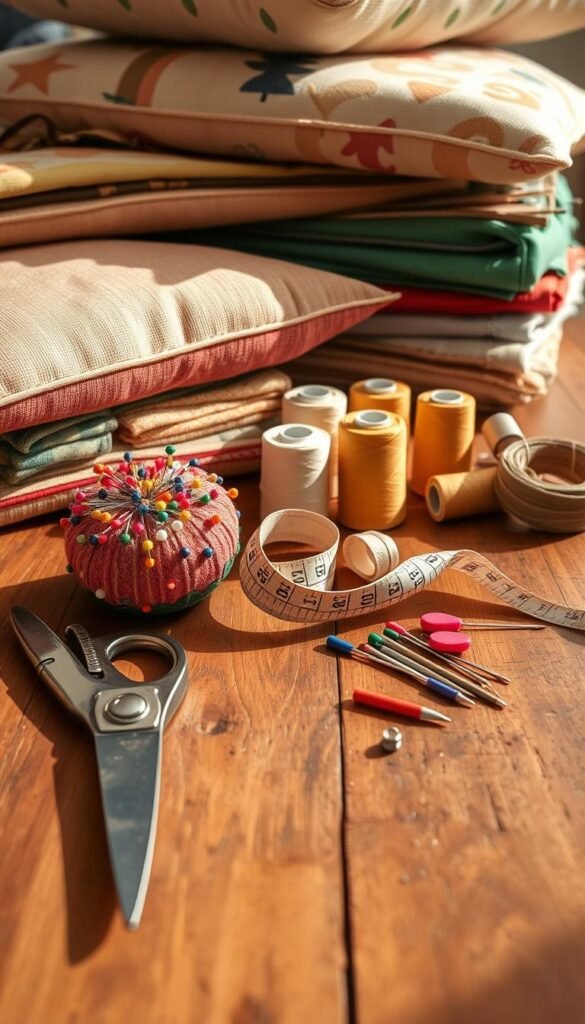
Essential Sewing Supplies
A well-stocked toolkit simplifies the creative process. Start with sharp fabric scissors—blunt edges fray delicate materials. Choose universal needles (size 80/12) that handle most woven fabrics smoothly.
Other must-haves include:
- 100% polyester thread for strength and colorfastness
- Seam ripper for quick corrections
- Fabric markers that vanish with water or heat
- Walking foot attachment for slippery fabrics
Types of Fabric Scraps That Work Best
Medium-weight natural fibers like cotton and linen offer ideal structure. Test fabric compatibility by checking edges—if they unravel easily, interface or zigzag stitching helps. Crisp shirting cotton blends work beautifully for geometric designs.
Avoid stretchy knits unless backed with stabilizer. Delicate silks require special handling but add luxurious contrast. Many crafters combine textures—denim patches with lace insets create dimensional interest.
Alternative Stuffing Options
For cloud-like filling, consider shredded memory foam from mattress toppers. One queen-sized topper yields enough stuffing for four 18″ pillows. Pre-wash all recycled materials in hot water to remove dust.
Other eco-choices include:
- Clumped plastic shopping bags (great for outdoor pillows)
- Cut-up felted wool sweaters (naturally mold-resistant)
- Retired cotton towels (washed and fluffed)
Store scraps in clear bins sorted by color or fiber content. This system makes future projects faster and more organized.
Step-by-Step Guide to Sewing Your Pillow
Transforming textile remnants into cozy accents requires patience and precision. This five-hour project yields professional results with proper technique—whether stitching by hand or machine. Follow these stages to craft a piece that blends function with artistic flair.
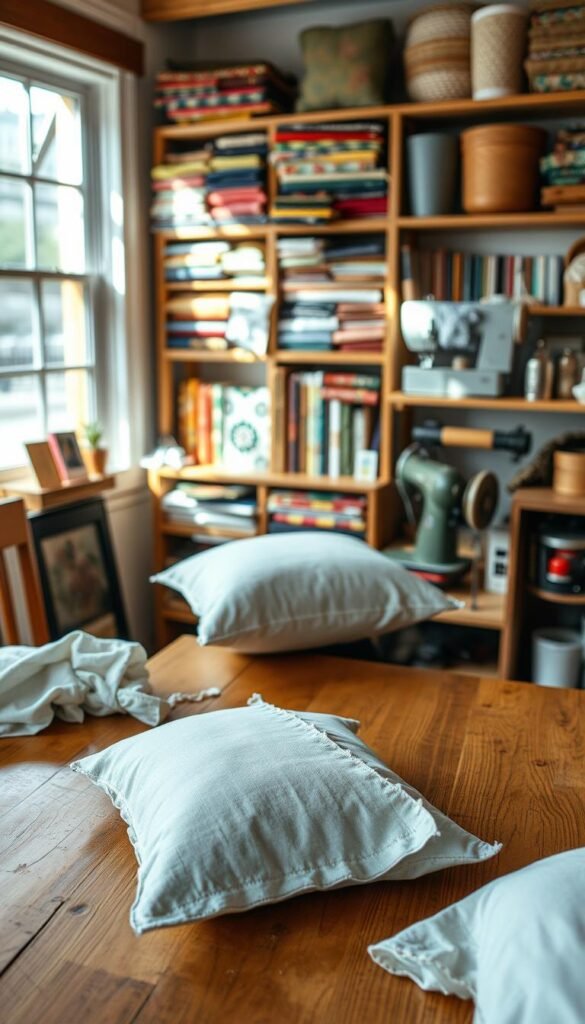
Preparing and Cutting Fabric Scraps
Begin by sorting remnants by color and texture. Lay pieces on grid paper to visualize patterns before cutting. Use sharp scissors for clean edges—blunt tools cause fraying.
Key steps:
- Press each piece with medium heat to remove wrinkles
- Mark measurements using water-soluble fabric markers
- Cut ½” larger than final size for seam allowance
- Store sorted pieces in labeled bins for future projects
Sewing the Patchwork Front Panel
Arrange cut pieces right side up on a flat surface. Pin adjacent edges before stitching to prevent shifting. A walking foot attachment helps feed multiple layers evenly.
| Stitch Type | Best For | Tension Setting |
|---|---|---|
| Straight stitch | Most woven fabrics | 3-4 |
| Zigzag | Stretchy or delicate materials | 2-3 |
| French seam | Sheer fabrics needing clean finish | 4-5 |
Assembling the Pillow Cover
Choose from three closure methods based on skill level. Envelope backs suit beginners, while invisible zippers offer polished results. For child-safe options, consider overlap closures with reinforced stitching.
Pro tips:
- Press seams open with starch for crisp edges
- Clip corners at 45° angles before turning right side out
- Topstitch ¼” from edge for structural definition
Inserting Stuffing and Finishing Touches
Calculate filling density by pillow size—18oz per 16″ square maintains ideal loft. Distribute stuffing evenly, paying extra attention to corners. For plump results, overfill by 10% then compress slightly.
Final steps include:
- Hand-stitching the opening with ladder stitch
- Steaming to remove any wrinkles
- Adding decorative elements like fabric tassels or embroidery
Allow 24 hours for materials to settle before final fluffing. Rotate pillows weekly to maintain even wear patterns.
Design Ideas for Unique Throw Pillows
Patterns and textures transform simple materials into eye-catching home accessories. Whether arranging geometric precision or freeform artistry, these approaches turn remnants into conversation-starting pieces. The right combination elevates any living room from ordinary to extraordinary.
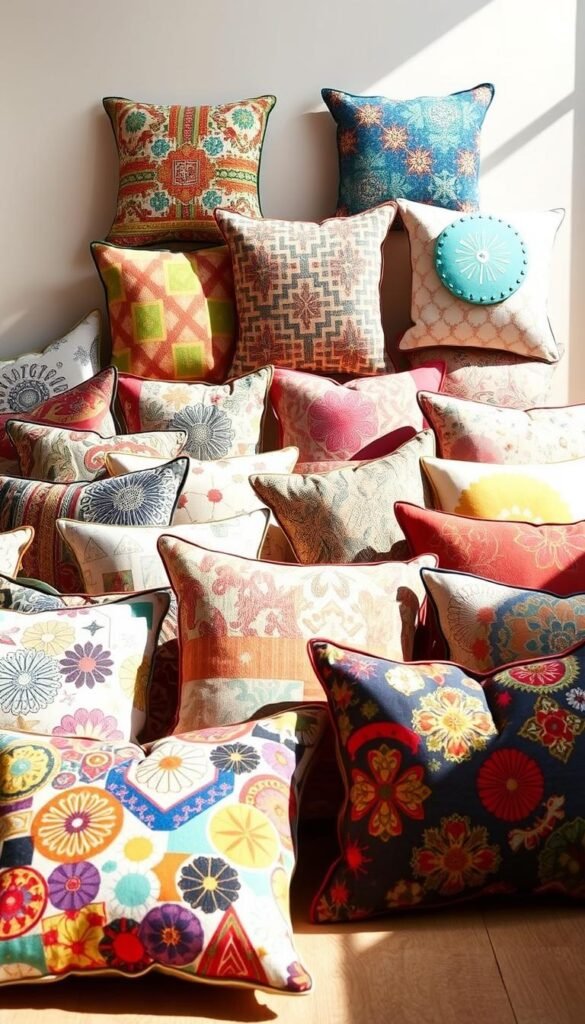
Patchwork Patterns: Grids, Stripes, and Improvisation
Structural designs create visual rhythm. Japanese sashiko stitching adds texture to grid layouts, while Amish quilting traditions demonstrate color blocking. For beginners, striped arrangements using 3″ fabric strips offer foolproof results.
Advanced techniques include:
- Trapunto quilting for dimensional raised sections
- Irregular hexagons inspired by English paper piecing
- Foundation piecing with muslin backing for stability
| Pattern Type | Skill Level | Best Fabric Pairings |
|---|---|---|
| Rail Fence | Beginner | Cotton shirting, linen blends |
| Log Cabin | Intermediate | Wool scraps, denim accents |
| Crazy Quilt | Advanced | Silk remnants, lace inserts |
Mixing Textures for Tactile Appeal
Contrasting materials add depth to designs. A Greek tea towel’s fringe edges create boho flair when paired with crisp cotton. For winter themes, repurposed sweater yarn forms 3D snowflakes against smooth velvet.
Successful combinations:
- Lace overlays on solid linen (washed for softness)
- Burlap strips with satin ribbon trim
- Felted wool circles on canvas backing
Embellishment Techniques That Stand Out
Final details personalize creations. Hand-stitched embroidery transforms plain covers into heirlooms. For holiday themes, consider:
- Appliquéd felt holly leaves with bead berries
- Upcycled jewelry as decorative closures
- Fabric-painted monograms using freezer paper stencils
Seasonal rotations keep decor fresh—spring might feature pastel crewelwork, while autumn showcases burnt orange cording. Always test embellishment durability with a steam iron before final attachment.
Conclusion
Every handmade pillow celebrates creativity while honoring resources. These cozy textures transform living spaces—one thoughtful stitch at a time. Share your finished projects with #ScrapStyleStories for feature chances on our blog.
For extended care tips, grab our free Textile Treasure Guide PDF. It covers cleaning methods and storage solutions to keep your home accents vibrant. New crafters can join next month’s Fabric Challenge Series.
We’d love to see your creations in the comments! Thanks for spending time with this tutorial. Stay tuned for our scrap fabric wall art post—coming soon to the blog. As designer Kaffe Fassett said, “Color is the unspoken language of comfort.”
